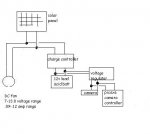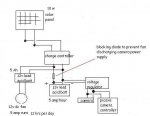My project is a solar powered time lapse camera that will be in a very warm environment (desert- lots of sun).
I plan to have a cooling fan that is turned on /off by the picaxe (based on time of day read from real time clock).
When the fan is on, it assumed there will be lots of sun and power generated.
The output of the solar panel can be as much as 17 volts. The fan has a allowable range of 7-13.8 v.
My schematic shows a 12 volt battery that is intended to serve the camera and picaxe circuit board. A voltage regulator is planned to reduce this to 7.4 v. (The picaxe circuit board has its own voltage regulator that will further reduce its voltage to 5v).
I would like to power the fan directly from the solar panel to prevent it from running off the battery power.
What is the simplest way to prevent the fan motor from getting too much voltage. Also, would low voltage damage the fan motor?
Thank you.
I plan to have a cooling fan that is turned on /off by the picaxe (based on time of day read from real time clock).
When the fan is on, it assumed there will be lots of sun and power generated.
The output of the solar panel can be as much as 17 volts. The fan has a allowable range of 7-13.8 v.
My schematic shows a 12 volt battery that is intended to serve the camera and picaxe circuit board. A voltage regulator is planned to reduce this to 7.4 v. (The picaxe circuit board has its own voltage regulator that will further reduce its voltage to 5v).
I would like to power the fan directly from the solar panel to prevent it from running off the battery power.
What is the simplest way to prevent the fan motor from getting too much voltage. Also, would low voltage damage the fan motor?
Thank you.
Attachments
-
15.5 KB Views: 63
Last edited:


